MGMT6000 Dynamic Leadership: Reflective Journal and Future Journey
VerifiedAdded on 2023/06/13
|16
|3092
|328
Journal and Reflective Writing
AI Summary
This reflective journal evaluates leadership concepts, theories, and models, including transactional and transformational leadership. It uses self-awareness techniques like MBTI and SWOT analysis to assess strengths, weaknesses, opportunities, and threats. The journal also explores the influence of cultural backgrounds on leadership styles and includes a detailed action plan to enhance emotional intelligence and address identified weaknesses in articulation of thought. The ultimate goal is to develop a personal and professional development plan for continued leadership growth. Desklib is a platform where students can find similar solved assignments.
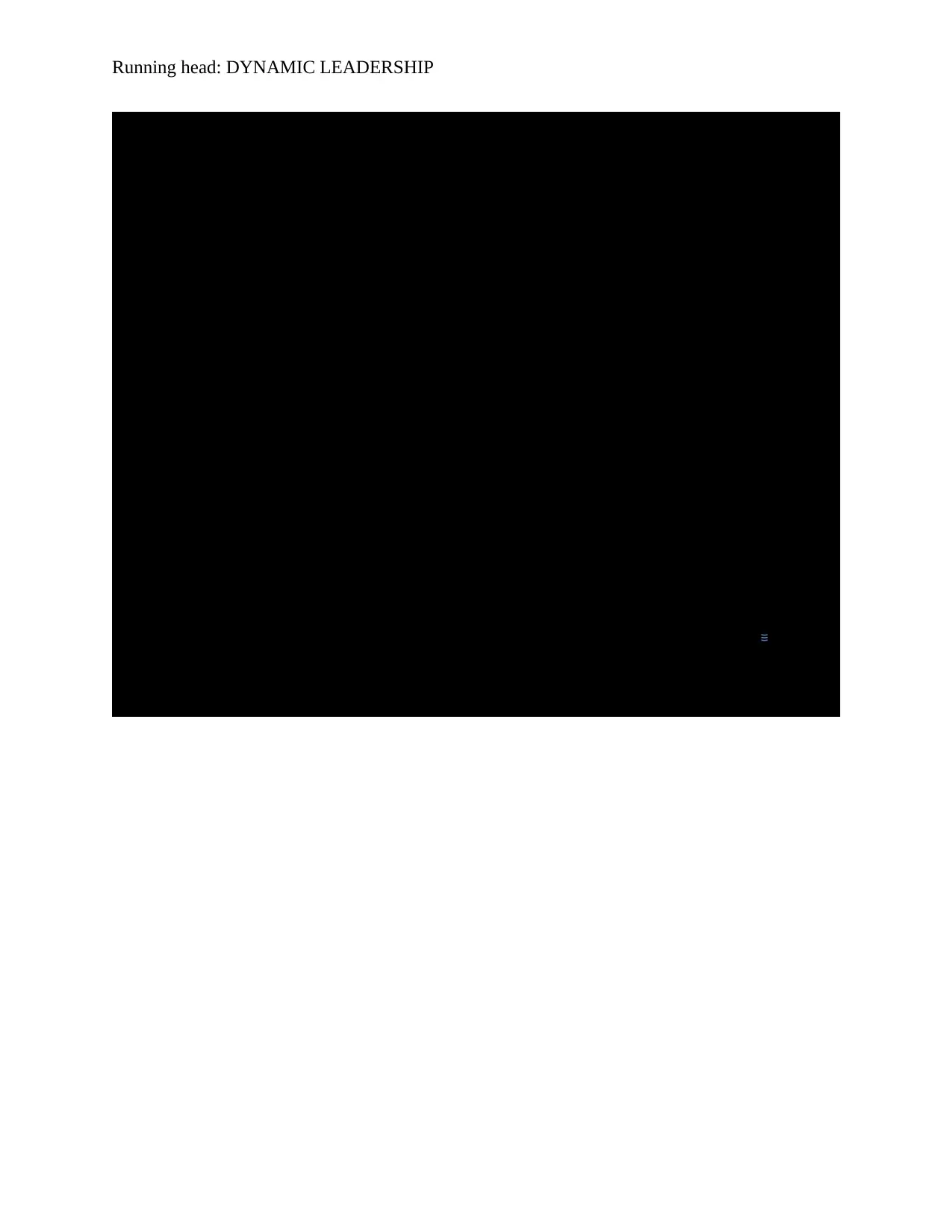
Running head: DYNAMIC LEADERSHIP
Paraphrase This Document
Need a fresh take? Get an instant paraphrase of this document with our AI Paraphraser
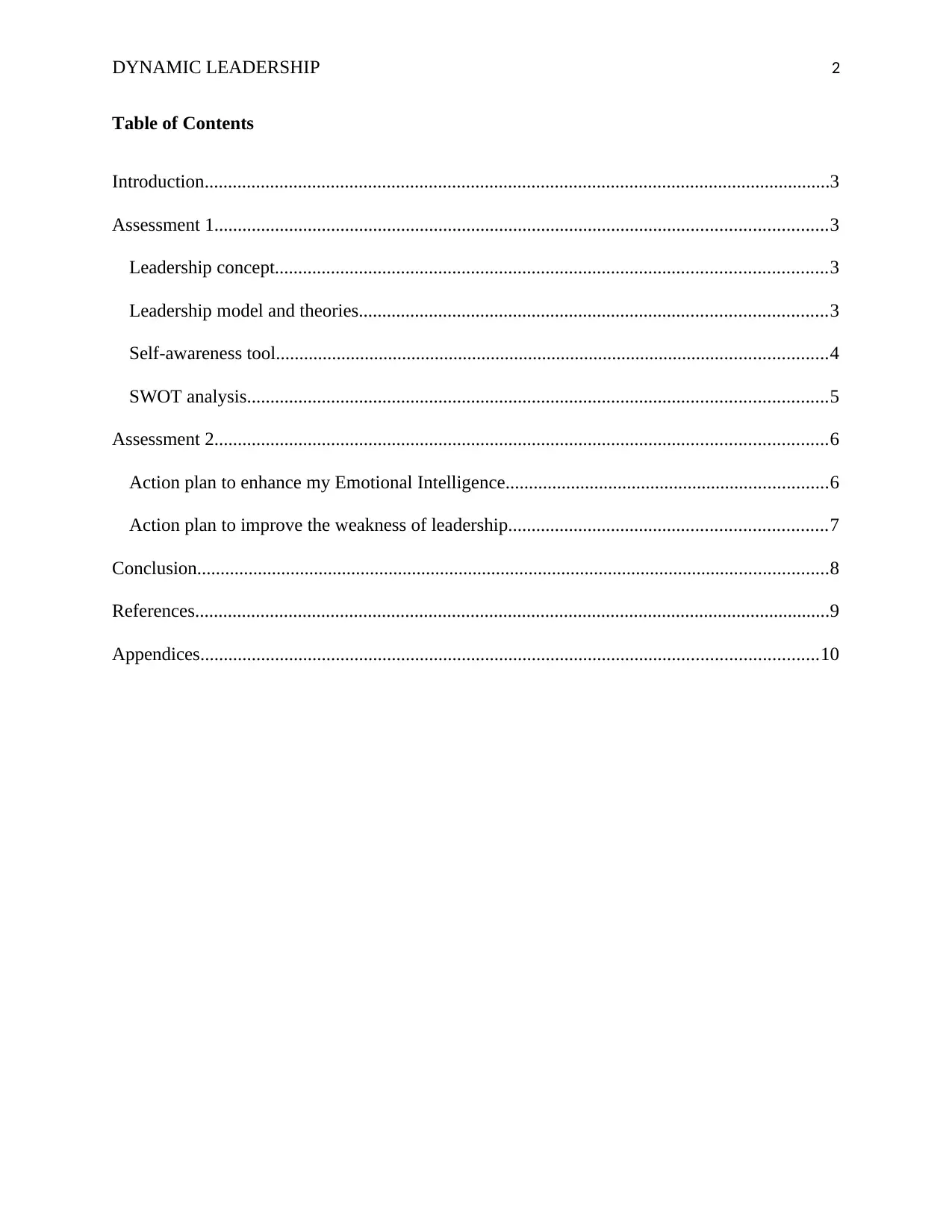
DYNAMIC LEADERSHIP 2
Table of Contents
Introduction......................................................................................................................................3
Assessment 1...................................................................................................................................3
Leadership concept......................................................................................................................3
Leadership model and theories....................................................................................................3
Self-awareness tool......................................................................................................................4
SWOT analysis............................................................................................................................5
Assessment 2...................................................................................................................................6
Action plan to enhance my Emotional Intelligence.....................................................................6
Action plan to improve the weakness of leadership....................................................................7
Conclusion.......................................................................................................................................8
References........................................................................................................................................9
Appendices....................................................................................................................................10
Table of Contents
Introduction......................................................................................................................................3
Assessment 1...................................................................................................................................3
Leadership concept......................................................................................................................3
Leadership model and theories....................................................................................................3
Self-awareness tool......................................................................................................................4
SWOT analysis............................................................................................................................5
Assessment 2...................................................................................................................................6
Action plan to enhance my Emotional Intelligence.....................................................................6
Action plan to improve the weakness of leadership....................................................................7
Conclusion.......................................................................................................................................8
References........................................................................................................................................9
Appendices....................................................................................................................................10
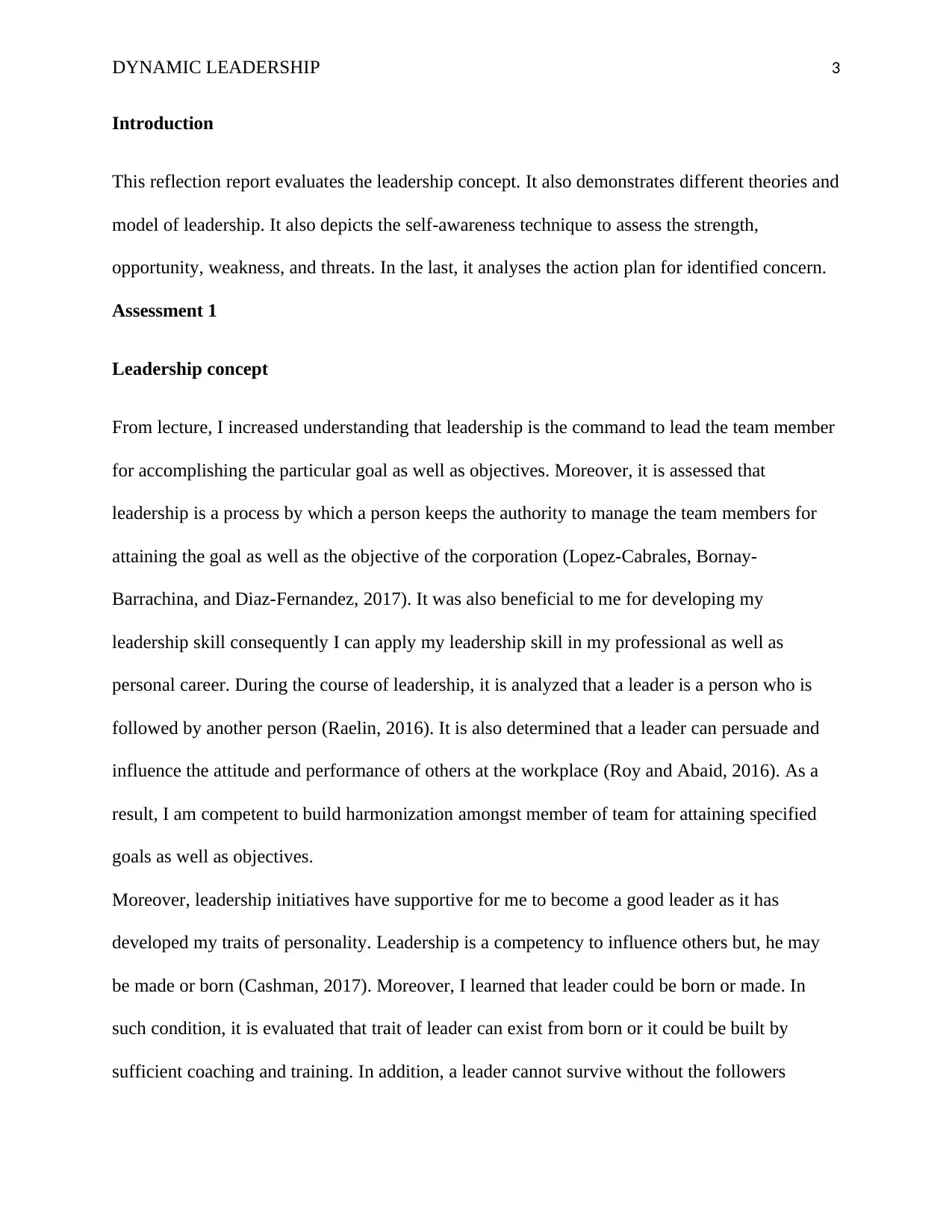
DYNAMIC LEADERSHIP 3
Introduction
This reflection report evaluates the leadership concept. It also demonstrates different theories and
model of leadership. It also depicts the self-awareness technique to assess the strength,
opportunity, weakness, and threats. In the last, it analyses the action plan for identified concern.
Assessment 1
Leadership concept
From lecture, I increased understanding that leadership is the command to lead the team member
for accomplishing the particular goal as well as objectives. Moreover, it is assessed that
leadership is a process by which a person keeps the authority to manage the team members for
attaining the goal as well as the objective of the corporation (Lopez-Cabrales, Bornay-
Barrachina, and Diaz-Fernandez, 2017). It was also beneficial to me for developing my
leadership skill consequently I can apply my leadership skill in my professional as well as
personal career. During the course of leadership, it is analyzed that a leader is a person who is
followed by another person (Raelin, 2016). It is also determined that a leader can persuade and
influence the attitude and performance of others at the workplace (Roy and Abaid, 2016). As a
result, I am competent to build harmonization amongst member of team for attaining specified
goals as well as objectives.
Moreover, leadership initiatives have supportive for me to become a good leader as it has
developed my traits of personality. Leadership is a competency to influence others but, he may
be made or born (Cashman, 2017). Moreover, I learned that leader could be born or made. In
such condition, it is evaluated that trait of leader can exist from born or it could be built by
sufficient coaching and training. In addition, a leader cannot survive without the followers
Introduction
This reflection report evaluates the leadership concept. It also demonstrates different theories and
model of leadership. It also depicts the self-awareness technique to assess the strength,
opportunity, weakness, and threats. In the last, it analyses the action plan for identified concern.
Assessment 1
Leadership concept
From lecture, I increased understanding that leadership is the command to lead the team member
for accomplishing the particular goal as well as objectives. Moreover, it is assessed that
leadership is a process by which a person keeps the authority to manage the team members for
attaining the goal as well as the objective of the corporation (Lopez-Cabrales, Bornay-
Barrachina, and Diaz-Fernandez, 2017). It was also beneficial to me for developing my
leadership skill consequently I can apply my leadership skill in my professional as well as
personal career. During the course of leadership, it is analyzed that a leader is a person who is
followed by another person (Raelin, 2016). It is also determined that a leader can persuade and
influence the attitude and performance of others at the workplace (Roy and Abaid, 2016). As a
result, I am competent to build harmonization amongst member of team for attaining specified
goals as well as objectives.
Moreover, leadership initiatives have supportive for me to become a good leader as it has
developed my traits of personality. Leadership is a competency to influence others but, he may
be made or born (Cashman, 2017). Moreover, I learned that leader could be born or made. In
such condition, it is evaluated that trait of leader can exist from born or it could be built by
sufficient coaching and training. In addition, a leader cannot survive without the followers
⊘ This is a preview!⊘
Do you want full access?
Subscribe today to unlock all pages.

Trusted by 1+ million students worldwide
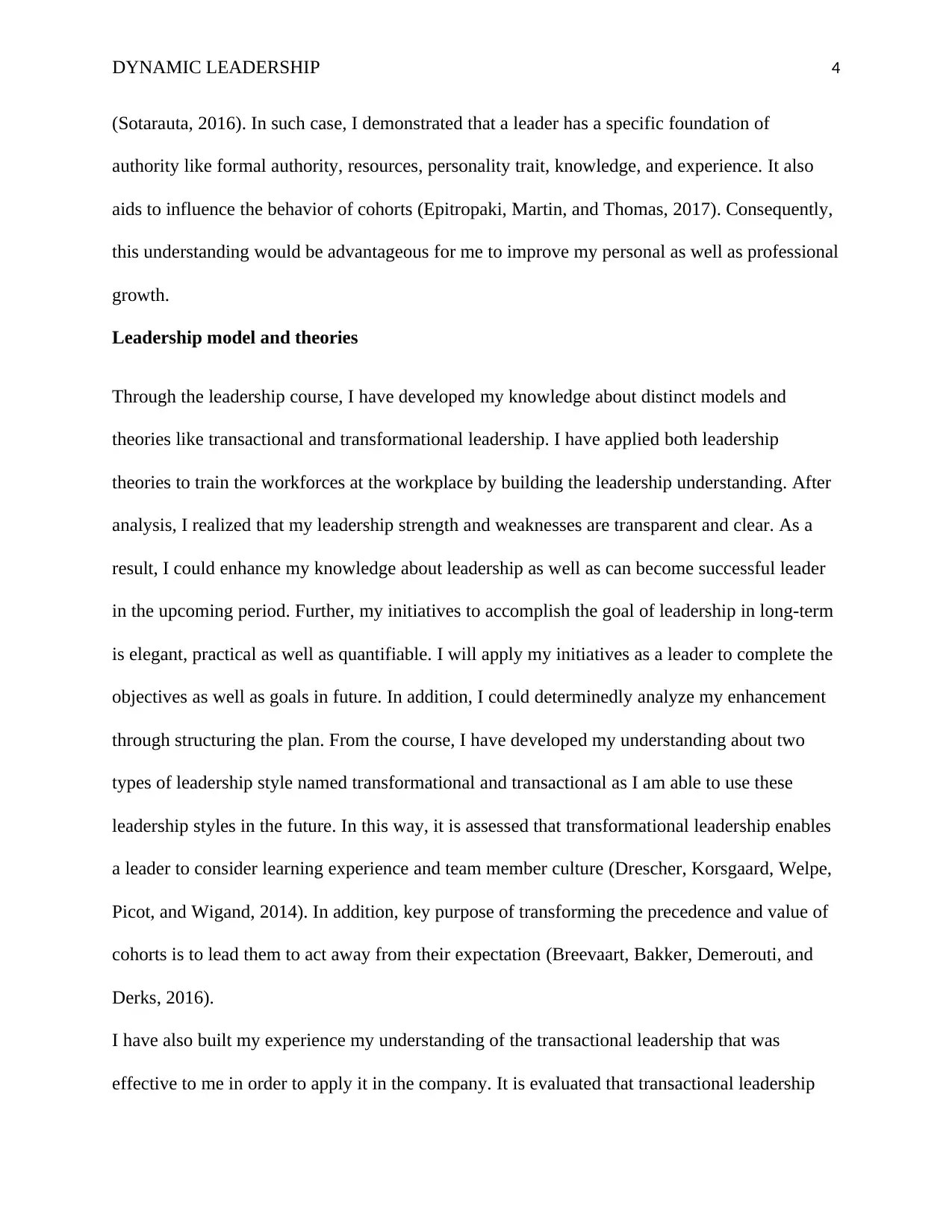
DYNAMIC LEADERSHIP 4
(Sotarauta, 2016). In such case, I demonstrated that a leader has a specific foundation of
authority like formal authority, resources, personality trait, knowledge, and experience. It also
aids to influence the behavior of cohorts (Epitropaki, Martin, and Thomas, 2017). Consequently,
this understanding would be advantageous for me to improve my personal as well as professional
growth.
Leadership model and theories
Through the leadership course, I have developed my knowledge about distinct models and
theories like transactional and transformational leadership. I have applied both leadership
theories to train the workforces at the workplace by building the leadership understanding. After
analysis, I realized that my leadership strength and weaknesses are transparent and clear. As a
result, I could enhance my knowledge about leadership as well as can become successful leader
in the upcoming period. Further, my initiatives to accomplish the goal of leadership in long-term
is elegant, practical as well as quantifiable. I will apply my initiatives as a leader to complete the
objectives as well as goals in future. In addition, I could determinedly analyze my enhancement
through structuring the plan. From the course, I have developed my understanding about two
types of leadership style named transformational and transactional as I am able to use these
leadership styles in the future. In this way, it is assessed that transformational leadership enables
a leader to consider learning experience and team member culture (Drescher, Korsgaard, Welpe,
Picot, and Wigand, 2014). In addition, key purpose of transforming the precedence and value of
cohorts is to lead them to act away from their expectation (Breevaart, Bakker, Demerouti, and
Derks, 2016).
I have also built my experience my understanding of the transactional leadership that was
effective to me in order to apply it in the company. It is evaluated that transactional leadership
(Sotarauta, 2016). In such case, I demonstrated that a leader has a specific foundation of
authority like formal authority, resources, personality trait, knowledge, and experience. It also
aids to influence the behavior of cohorts (Epitropaki, Martin, and Thomas, 2017). Consequently,
this understanding would be advantageous for me to improve my personal as well as professional
growth.
Leadership model and theories
Through the leadership course, I have developed my knowledge about distinct models and
theories like transactional and transformational leadership. I have applied both leadership
theories to train the workforces at the workplace by building the leadership understanding. After
analysis, I realized that my leadership strength and weaknesses are transparent and clear. As a
result, I could enhance my knowledge about leadership as well as can become successful leader
in the upcoming period. Further, my initiatives to accomplish the goal of leadership in long-term
is elegant, practical as well as quantifiable. I will apply my initiatives as a leader to complete the
objectives as well as goals in future. In addition, I could determinedly analyze my enhancement
through structuring the plan. From the course, I have developed my understanding about two
types of leadership style named transformational and transactional as I am able to use these
leadership styles in the future. In this way, it is assessed that transformational leadership enables
a leader to consider learning experience and team member culture (Drescher, Korsgaard, Welpe,
Picot, and Wigand, 2014). In addition, key purpose of transforming the precedence and value of
cohorts is to lead them to act away from their expectation (Breevaart, Bakker, Demerouti, and
Derks, 2016).
I have also built my experience my understanding of the transactional leadership that was
effective to me in order to apply it in the company. It is evaluated that transactional leadership
Paraphrase This Document
Need a fresh take? Get an instant paraphrase of this document with our AI Paraphraser
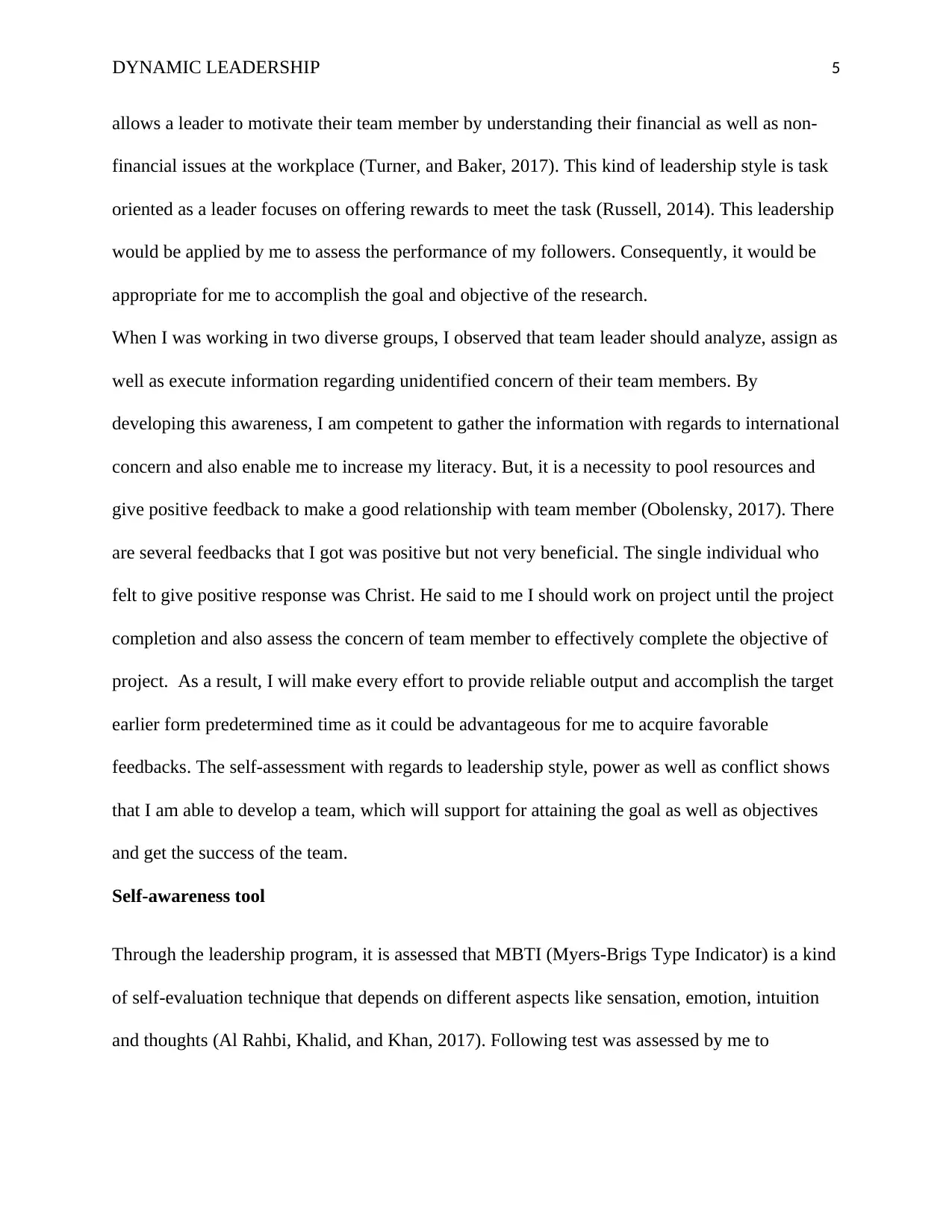
DYNAMIC LEADERSHIP 5
allows a leader to motivate their team member by understanding their financial as well as non-
financial issues at the workplace (Turner, and Baker, 2017). This kind of leadership style is task
oriented as a leader focuses on offering rewards to meet the task (Russell, 2014). This leadership
would be applied by me to assess the performance of my followers. Consequently, it would be
appropriate for me to accomplish the goal and objective of the research.
When I was working in two diverse groups, I observed that team leader should analyze, assign as
well as execute information regarding unidentified concern of their team members. By
developing this awareness, I am competent to gather the information with regards to international
concern and also enable me to increase my literacy. But, it is a necessity to pool resources and
give positive feedback to make a good relationship with team member (Obolensky, 2017). There
are several feedbacks that I got was positive but not very beneficial. The single individual who
felt to give positive response was Christ. He said to me I should work on project until the project
completion and also assess the concern of team member to effectively complete the objective of
project. As a result, I will make every effort to provide reliable output and accomplish the target
earlier form predetermined time as it could be advantageous for me to acquire favorable
feedbacks. The self-assessment with regards to leadership style, power as well as conflict shows
that I am able to develop a team, which will support for attaining the goal as well as objectives
and get the success of the team.
Self-awareness tool
Through the leadership program, it is assessed that MBTI (Myers-Brigs Type Indicator) is a kind
of self-evaluation technique that depends on different aspects like sensation, emotion, intuition
and thoughts (Al Rahbi, Khalid, and Khan, 2017). Following test was assessed by me to
allows a leader to motivate their team member by understanding their financial as well as non-
financial issues at the workplace (Turner, and Baker, 2017). This kind of leadership style is task
oriented as a leader focuses on offering rewards to meet the task (Russell, 2014). This leadership
would be applied by me to assess the performance of my followers. Consequently, it would be
appropriate for me to accomplish the goal and objective of the research.
When I was working in two diverse groups, I observed that team leader should analyze, assign as
well as execute information regarding unidentified concern of their team members. By
developing this awareness, I am competent to gather the information with regards to international
concern and also enable me to increase my literacy. But, it is a necessity to pool resources and
give positive feedback to make a good relationship with team member (Obolensky, 2017). There
are several feedbacks that I got was positive but not very beneficial. The single individual who
felt to give positive response was Christ. He said to me I should work on project until the project
completion and also assess the concern of team member to effectively complete the objective of
project. As a result, I will make every effort to provide reliable output and accomplish the target
earlier form predetermined time as it could be advantageous for me to acquire favorable
feedbacks. The self-assessment with regards to leadership style, power as well as conflict shows
that I am able to develop a team, which will support for attaining the goal as well as objectives
and get the success of the team.
Self-awareness tool
Through the leadership program, it is assessed that MBTI (Myers-Brigs Type Indicator) is a kind
of self-evaluation technique that depends on different aspects like sensation, emotion, intuition
and thoughts (Al Rahbi, Khalid, and Khan, 2017). Following test was assessed by me to
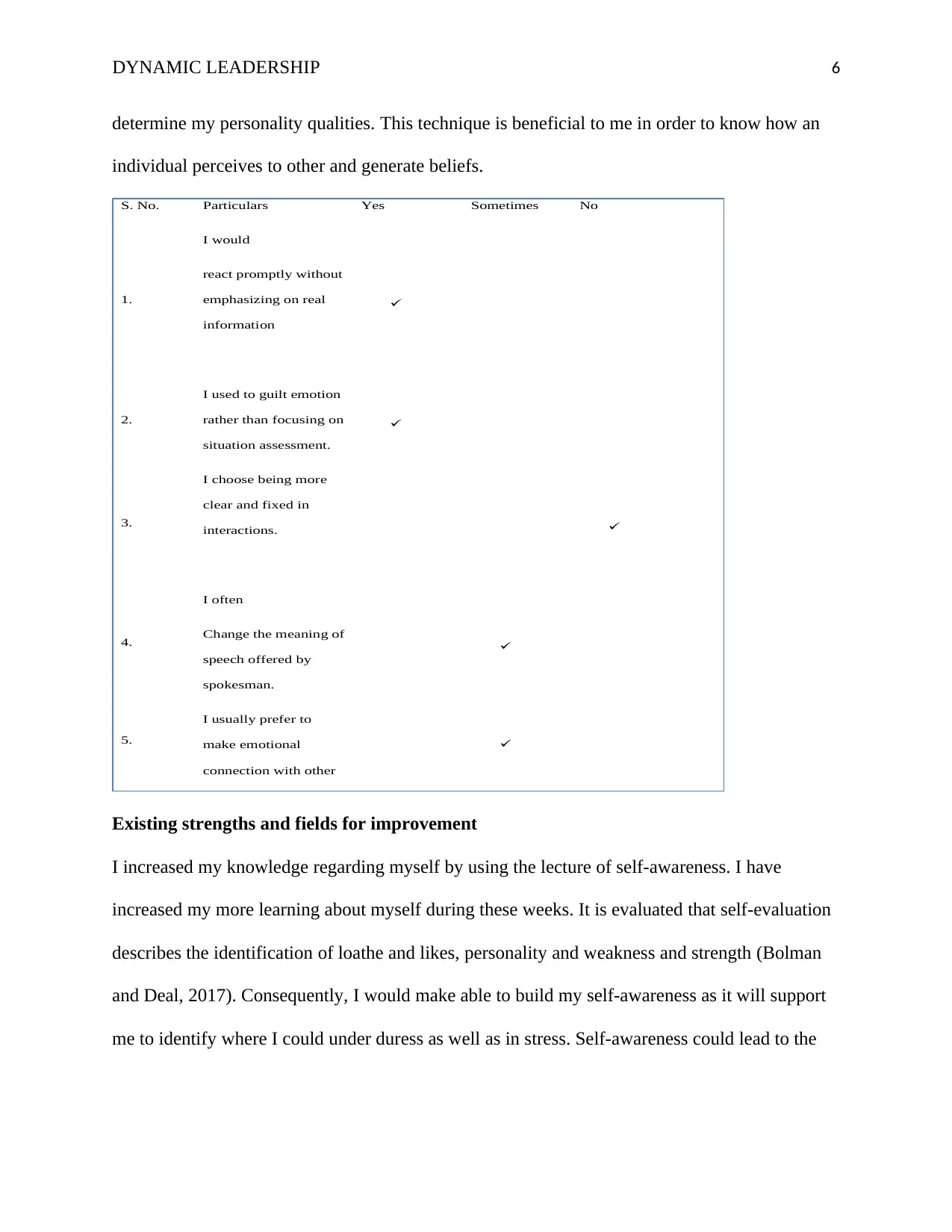
DYNAMIC LEADERSHIP 6
determine my personality qualities. This technique is beneficial to me in order to know how an
individual perceives to other and generate beliefs.
S. No. Particulars Yes Sometimes No
1.
I would
react promptly without
emphasizing on real
information
2.
I used to guilt emotion
rather than focusing on
situation assessment.
3.
I choose being more
clear and fixed in
interactions.
4.
I often
Change the meaning of
speech offered by
spokesman.
5.
I usually prefer to
make emotional
connection with other
Existing strengths and fields for improvement
I increased my knowledge regarding myself by using the lecture of self-awareness. I have
increased my more learning about myself during these weeks. It is evaluated that self-evaluation
describes the identification of loathe and likes, personality and weakness and strength (Bolman
and Deal, 2017). Consequently, I would make able to build my self-awareness as it will support
me to identify where I could under duress as well as in stress. Self-awareness could lead to the
determine my personality qualities. This technique is beneficial to me in order to know how an
individual perceives to other and generate beliefs.
S. No. Particulars Yes Sometimes No
1.
I would
react promptly without
emphasizing on real
information
2.
I used to guilt emotion
rather than focusing on
situation assessment.
3.
I choose being more
clear and fixed in
interactions.
4.
I often
Change the meaning of
speech offered by
spokesman.
5.
I usually prefer to
make emotional
connection with other
Existing strengths and fields for improvement
I increased my knowledge regarding myself by using the lecture of self-awareness. I have
increased my more learning about myself during these weeks. It is evaluated that self-evaluation
describes the identification of loathe and likes, personality and weakness and strength (Bolman
and Deal, 2017). Consequently, I would make able to build my self-awareness as it will support
me to identify where I could under duress as well as in stress. Self-awareness could lead to the
⊘ This is a preview!⊘
Do you want full access?
Subscribe today to unlock all pages.

Trusted by 1+ million students worldwide
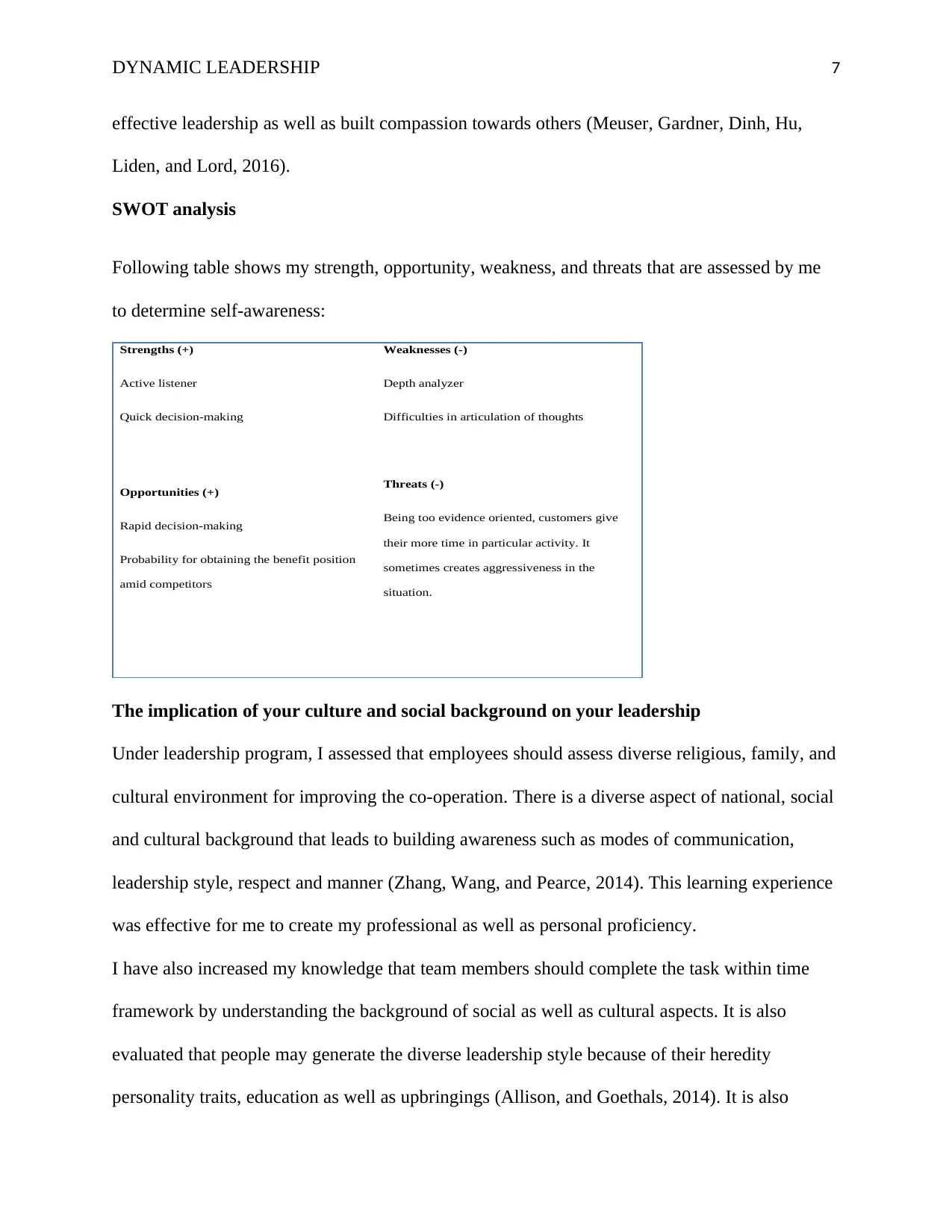
DYNAMIC LEADERSHIP 7
effective leadership as well as built compassion towards others (Meuser, Gardner, Dinh, Hu,
Liden, and Lord, 2016).
SWOT analysis
Following table shows my strength, opportunity, weakness, and threats that are assessed by me
to determine self-awareness:
Strengths (+)
Active listener
Quick decision-making
Weaknesses (-)
Depth analyzer
Difficulties in articulation of thoughts
Opportunities (+)
Rapid decision-making
Probability for obtaining the benefit position
amid competitors
Threats (-)
Being too evidence oriented, customers give
their more time in particular activity. It
sometimes creates aggressiveness in the
situation.
The implication of your culture and social background on your leadership
Under leadership program, I assessed that employees should assess diverse religious, family, and
cultural environment for improving the co-operation. There is a diverse aspect of national, social
and cultural background that leads to building awareness such as modes of communication,
leadership style, respect and manner (Zhang, Wang, and Pearce, 2014). This learning experience
was effective for me to create my professional as well as personal proficiency.
I have also increased my knowledge that team members should complete the task within time
framework by understanding the background of social as well as cultural aspects. It is also
evaluated that people may generate the diverse leadership style because of their heredity
personality traits, education as well as upbringings (Allison, and Goethals, 2014). It is also
effective leadership as well as built compassion towards others (Meuser, Gardner, Dinh, Hu,
Liden, and Lord, 2016).
SWOT analysis
Following table shows my strength, opportunity, weakness, and threats that are assessed by me
to determine self-awareness:
Strengths (+)
Active listener
Quick decision-making
Weaknesses (-)
Depth analyzer
Difficulties in articulation of thoughts
Opportunities (+)
Rapid decision-making
Probability for obtaining the benefit position
amid competitors
Threats (-)
Being too evidence oriented, customers give
their more time in particular activity. It
sometimes creates aggressiveness in the
situation.
The implication of your culture and social background on your leadership
Under leadership program, I assessed that employees should assess diverse religious, family, and
cultural environment for improving the co-operation. There is a diverse aspect of national, social
and cultural background that leads to building awareness such as modes of communication,
leadership style, respect and manner (Zhang, Wang, and Pearce, 2014). This learning experience
was effective for me to create my professional as well as personal proficiency.
I have also increased my knowledge that team members should complete the task within time
framework by understanding the background of social as well as cultural aspects. It is also
evaluated that people may generate the diverse leadership style because of their heredity
personality traits, education as well as upbringings (Allison, and Goethals, 2014). It is also
Paraphrase This Document
Need a fresh take? Get an instant paraphrase of this document with our AI Paraphraser
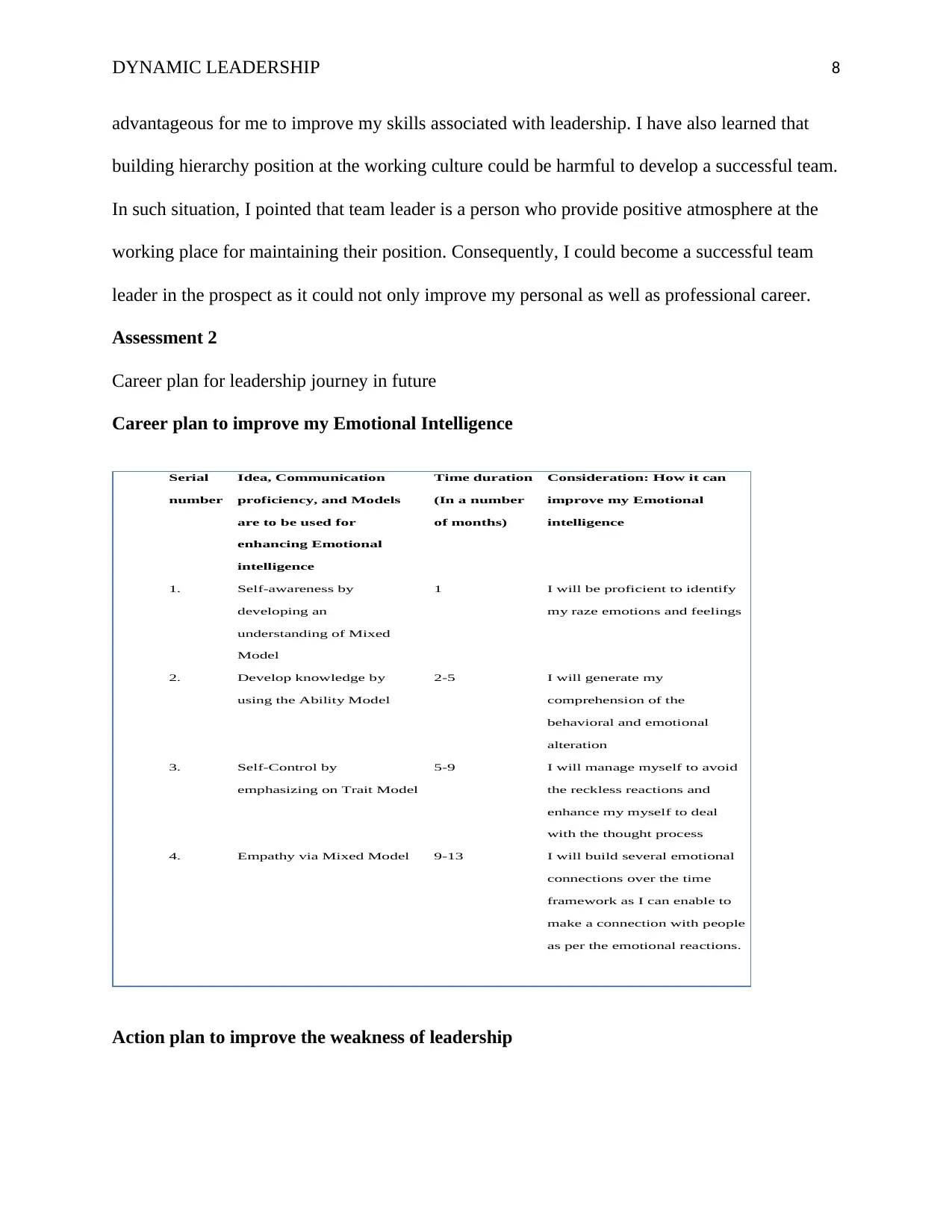
DYNAMIC LEADERSHIP 8
advantageous for me to improve my skills associated with leadership. I have also learned that
building hierarchy position at the working culture could be harmful to develop a successful team.
In such situation, I pointed that team leader is a person who provide positive atmosphere at the
working place for maintaining their position. Consequently, I could become a successful team
leader in the prospect as it could not only improve my personal as well as professional career.
Assessment 2
Career plan for leadership journey in future
Career plan to improve my Emotional Intelligence
Serial
number
Idea, Communication
proficiency, and Models
are to be used for
enhancing Emotional
intelligence
Time duration
(In a number
of months)
Consideration: How it can
improve my Emotional
intelligence
1. Self-awareness by
developing an
understanding of Mixed
Model
1 I will be proficient to identify
my raze emotions and feelings
2. Develop knowledge by
using the Ability Model
2-5 I will generate my
comprehension of the
behavioral and emotional
alteration
3. Self-Control by
emphasizing on Trait Model
5-9 I will manage myself to avoid
the reckless reactions and
enhance my myself to deal
with the thought process
4. Empathy via Mixed Model 9-13 I will build several emotional
connections over the time
framework as I can enable to
make a connection with people
as per the emotional reactions.
Action plan to improve the weakness of leadership
advantageous for me to improve my skills associated with leadership. I have also learned that
building hierarchy position at the working culture could be harmful to develop a successful team.
In such situation, I pointed that team leader is a person who provide positive atmosphere at the
working place for maintaining their position. Consequently, I could become a successful team
leader in the prospect as it could not only improve my personal as well as professional career.
Assessment 2
Career plan for leadership journey in future
Career plan to improve my Emotional Intelligence
Serial
number
Idea, Communication
proficiency, and Models
are to be used for
enhancing Emotional
intelligence
Time duration
(In a number
of months)
Consideration: How it can
improve my Emotional
intelligence
1. Self-awareness by
developing an
understanding of Mixed
Model
1 I will be proficient to identify
my raze emotions and feelings
2. Develop knowledge by
using the Ability Model
2-5 I will generate my
comprehension of the
behavioral and emotional
alteration
3. Self-Control by
emphasizing on Trait Model
5-9 I will manage myself to avoid
the reckless reactions and
enhance my myself to deal
with the thought process
4. Empathy via Mixed Model 9-13 I will build several emotional
connections over the time
framework as I can enable to
make a connection with people
as per the emotional reactions.
Action plan to improve the weakness of leadership
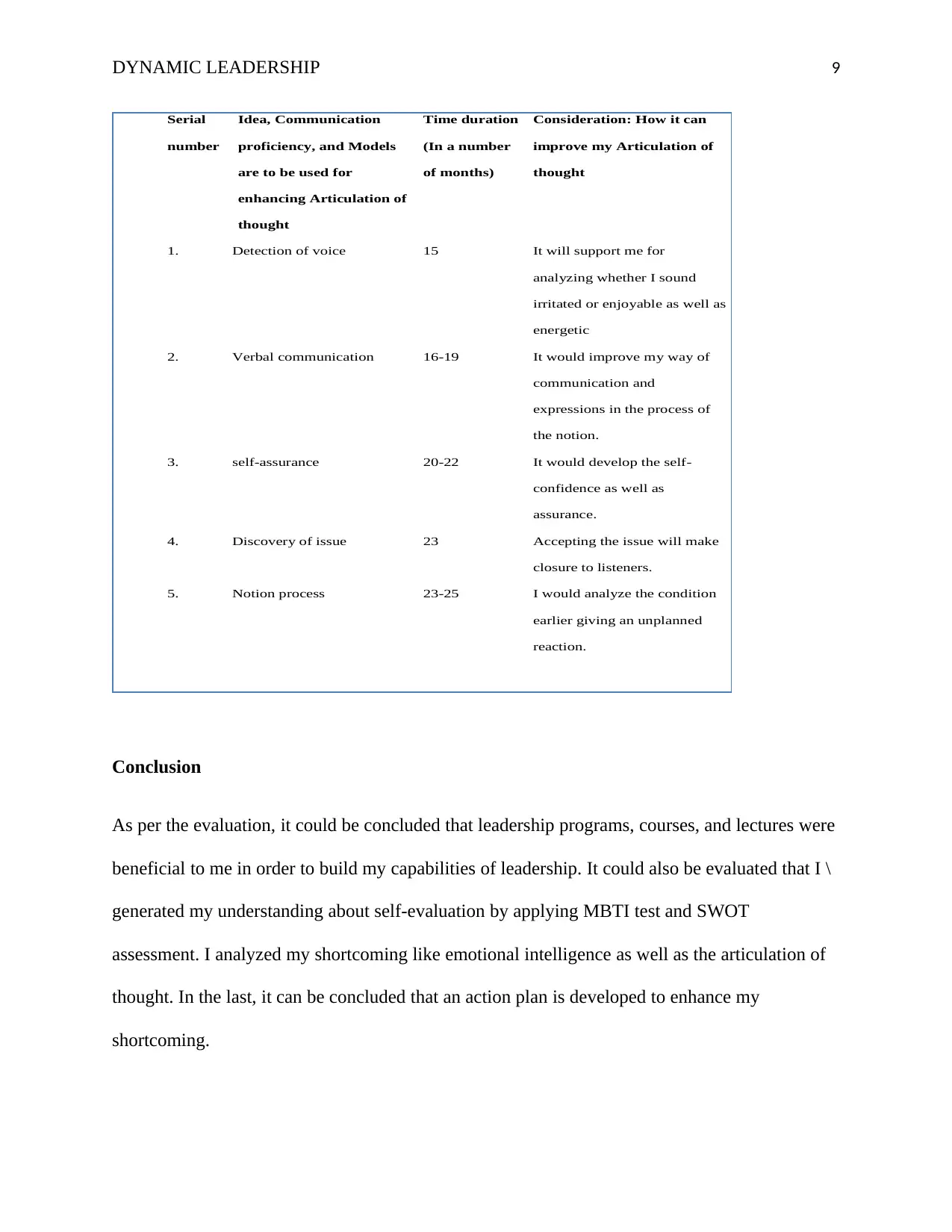
DYNAMIC LEADERSHIP 9
Serial
number
Idea, Communication
proficiency, and Models
are to be used for
enhancing Articulation of
thought
Time duration
(In a number
of months)
Consideration: How it can
improve my Articulation of
thought
1. Detection of voice 15 It will support me for
analyzing whether I sound
irritated or enjoyable as well as
energetic
2. Verbal communication 16-19 It would improve my way of
communication and
expressions in the process of
the notion.
3. self-assurance 20-22 It would develop the self-
confidence as well as
assurance.
4. Discovery of issue 23 Accepting the issue will make
closure to listeners.
5. Notion process 23-25 I would analyze the condition
earlier giving an unplanned
reaction.
Conclusion
As per the evaluation, it could be concluded that leadership programs, courses, and lectures were
beneficial to me in order to build my capabilities of leadership. It could also be evaluated that I \
generated my understanding about self-evaluation by applying MBTI test and SWOT
assessment. I analyzed my shortcoming like emotional intelligence as well as the articulation of
thought. In the last, it can be concluded that an action plan is developed to enhance my
shortcoming.
Serial
number
Idea, Communication
proficiency, and Models
are to be used for
enhancing Articulation of
thought
Time duration
(In a number
of months)
Consideration: How it can
improve my Articulation of
thought
1. Detection of voice 15 It will support me for
analyzing whether I sound
irritated or enjoyable as well as
energetic
2. Verbal communication 16-19 It would improve my way of
communication and
expressions in the process of
the notion.
3. self-assurance 20-22 It would develop the self-
confidence as well as
assurance.
4. Discovery of issue 23 Accepting the issue will make
closure to listeners.
5. Notion process 23-25 I would analyze the condition
earlier giving an unplanned
reaction.
Conclusion
As per the evaluation, it could be concluded that leadership programs, courses, and lectures were
beneficial to me in order to build my capabilities of leadership. It could also be evaluated that I \
generated my understanding about self-evaluation by applying MBTI test and SWOT
assessment. I analyzed my shortcoming like emotional intelligence as well as the articulation of
thought. In the last, it can be concluded that an action plan is developed to enhance my
shortcoming.
⊘ This is a preview!⊘
Do you want full access?
Subscribe today to unlock all pages.

Trusted by 1+ million students worldwide
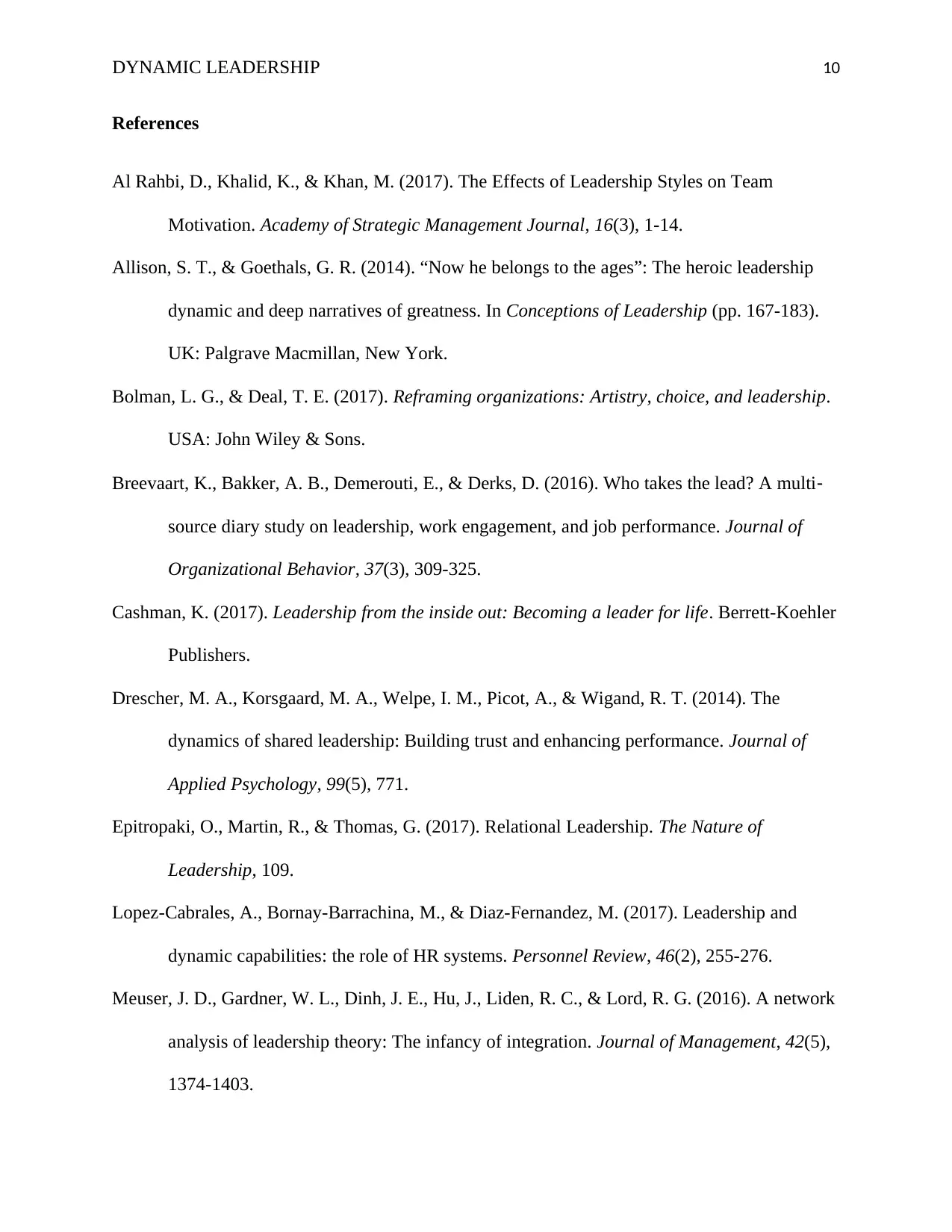
DYNAMIC LEADERSHIP 10
References
Al Rahbi, D., Khalid, K., & Khan, M. (2017). The Effects of Leadership Styles on Team
Motivation. Academy of Strategic Management Journal, 16(3), 1-14.
Allison, S. T., & Goethals, G. R. (2014). “Now he belongs to the ages”: The heroic leadership
dynamic and deep narratives of greatness. In Conceptions of Leadership (pp. 167-183).
UK: Palgrave Macmillan, New York.
Bolman, L. G., & Deal, T. E. (2017). Reframing organizations: Artistry, choice, and leadership.
USA: John Wiley & Sons.
Breevaart, K., Bakker, A. B., Demerouti, E., & Derks, D. (2016). Who takes the lead? A multi‐
source diary study on leadership, work engagement, and job performance. Journal of
Organizational Behavior, 37(3), 309-325.
Cashman, K. (2017). Leadership from the inside out: Becoming a leader for life. Berrett-Koehler
Publishers.
Drescher, M. A., Korsgaard, M. A., Welpe, I. M., Picot, A., & Wigand, R. T. (2014). The
dynamics of shared leadership: Building trust and enhancing performance. Journal of
Applied Psychology, 99(5), 771.
Epitropaki, O., Martin, R., & Thomas, G. (2017). Relational Leadership. The Nature of
Leadership, 109.
Lopez-Cabrales, A., Bornay-Barrachina, M., & Diaz-Fernandez, M. (2017). Leadership and
dynamic capabilities: the role of HR systems. Personnel Review, 46(2), 255-276.
Meuser, J. D., Gardner, W. L., Dinh, J. E., Hu, J., Liden, R. C., & Lord, R. G. (2016). A network
analysis of leadership theory: The infancy of integration. Journal of Management, 42(5),
1374-1403.
References
Al Rahbi, D., Khalid, K., & Khan, M. (2017). The Effects of Leadership Styles on Team
Motivation. Academy of Strategic Management Journal, 16(3), 1-14.
Allison, S. T., & Goethals, G. R. (2014). “Now he belongs to the ages”: The heroic leadership
dynamic and deep narratives of greatness. In Conceptions of Leadership (pp. 167-183).
UK: Palgrave Macmillan, New York.
Bolman, L. G., & Deal, T. E. (2017). Reframing organizations: Artistry, choice, and leadership.
USA: John Wiley & Sons.
Breevaart, K., Bakker, A. B., Demerouti, E., & Derks, D. (2016). Who takes the lead? A multi‐
source diary study on leadership, work engagement, and job performance. Journal of
Organizational Behavior, 37(3), 309-325.
Cashman, K. (2017). Leadership from the inside out: Becoming a leader for life. Berrett-Koehler
Publishers.
Drescher, M. A., Korsgaard, M. A., Welpe, I. M., Picot, A., & Wigand, R. T. (2014). The
dynamics of shared leadership: Building trust and enhancing performance. Journal of
Applied Psychology, 99(5), 771.
Epitropaki, O., Martin, R., & Thomas, G. (2017). Relational Leadership. The Nature of
Leadership, 109.
Lopez-Cabrales, A., Bornay-Barrachina, M., & Diaz-Fernandez, M. (2017). Leadership and
dynamic capabilities: the role of HR systems. Personnel Review, 46(2), 255-276.
Meuser, J. D., Gardner, W. L., Dinh, J. E., Hu, J., Liden, R. C., & Lord, R. G. (2016). A network
analysis of leadership theory: The infancy of integration. Journal of Management, 42(5),
1374-1403.
Paraphrase This Document
Need a fresh take? Get an instant paraphrase of this document with our AI Paraphraser
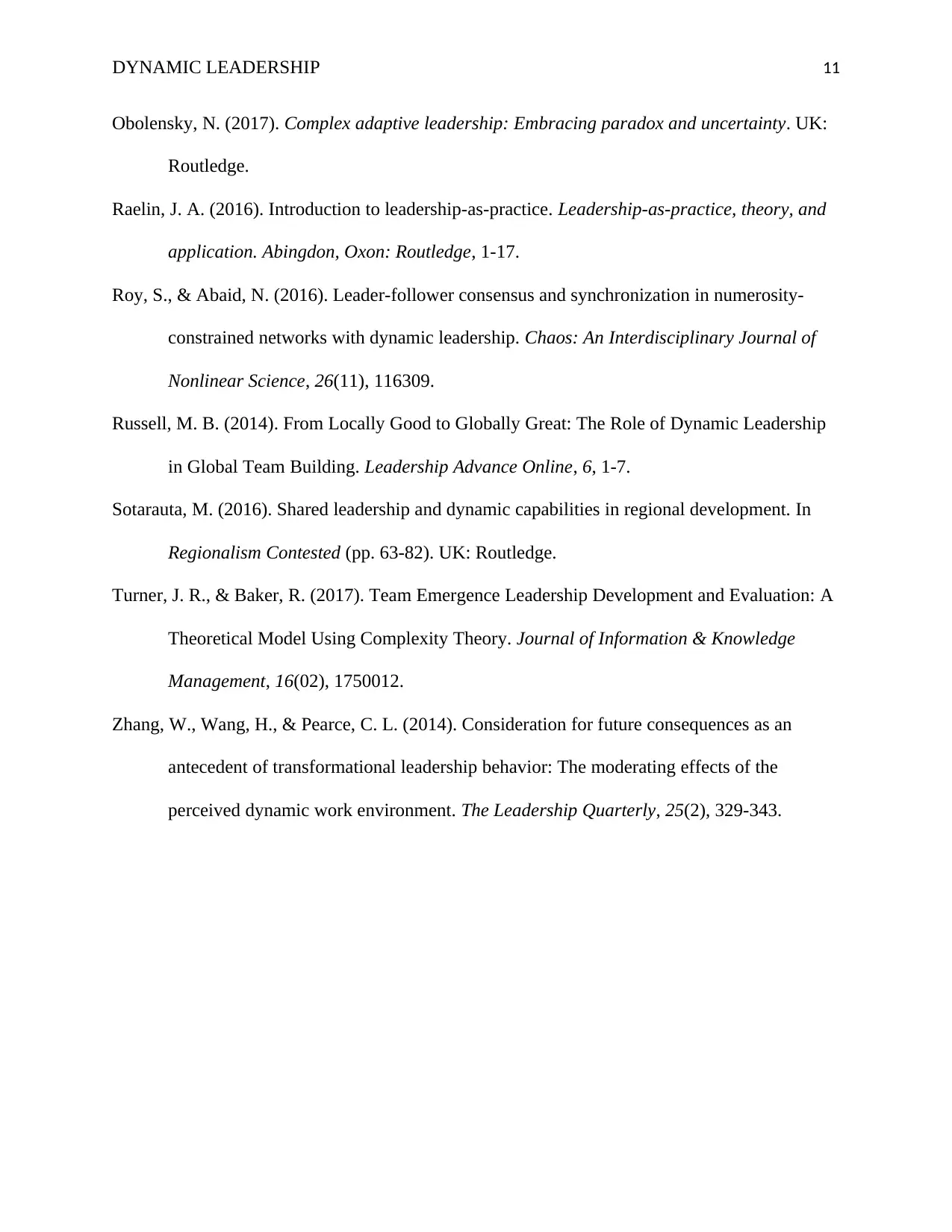
DYNAMIC LEADERSHIP 11
Obolensky, N. (2017). Complex adaptive leadership: Embracing paradox and uncertainty. UK:
Routledge.
Raelin, J. A. (2016). Introduction to leadership-as-practice. Leadership-as-practice, theory, and
application. Abingdon, Oxon: Routledge, 1-17.
Roy, S., & Abaid, N. (2016). Leader-follower consensus and synchronization in numerosity-
constrained networks with dynamic leadership. Chaos: An Interdisciplinary Journal of
Nonlinear Science, 26(11), 116309.
Russell, M. B. (2014). From Locally Good to Globally Great: The Role of Dynamic Leadership
in Global Team Building. Leadership Advance Online, 6, 1-7.
Sotarauta, M. (2016). Shared leadership and dynamic capabilities in regional development. In
Regionalism Contested (pp. 63-82). UK: Routledge.
Turner, J. R., & Baker, R. (2017). Team Emergence Leadership Development and Evaluation: A
Theoretical Model Using Complexity Theory. Journal of Information & Knowledge
Management, 16(02), 1750012.
Zhang, W., Wang, H., & Pearce, C. L. (2014). Consideration for future consequences as an
antecedent of transformational leadership behavior: The moderating effects of the
perceived dynamic work environment. The Leadership Quarterly, 25(2), 329-343.
Obolensky, N. (2017). Complex adaptive leadership: Embracing paradox and uncertainty. UK:
Routledge.
Raelin, J. A. (2016). Introduction to leadership-as-practice. Leadership-as-practice, theory, and
application. Abingdon, Oxon: Routledge, 1-17.
Roy, S., & Abaid, N. (2016). Leader-follower consensus and synchronization in numerosity-
constrained networks with dynamic leadership. Chaos: An Interdisciplinary Journal of
Nonlinear Science, 26(11), 116309.
Russell, M. B. (2014). From Locally Good to Globally Great: The Role of Dynamic Leadership
in Global Team Building. Leadership Advance Online, 6, 1-7.
Sotarauta, M. (2016). Shared leadership and dynamic capabilities in regional development. In
Regionalism Contested (pp. 63-82). UK: Routledge.
Turner, J. R., & Baker, R. (2017). Team Emergence Leadership Development and Evaluation: A
Theoretical Model Using Complexity Theory. Journal of Information & Knowledge
Management, 16(02), 1750012.
Zhang, W., Wang, H., & Pearce, C. L. (2014). Consideration for future consequences as an
antecedent of transformational leadership behavior: The moderating effects of the
perceived dynamic work environment. The Leadership Quarterly, 25(2), 329-343.
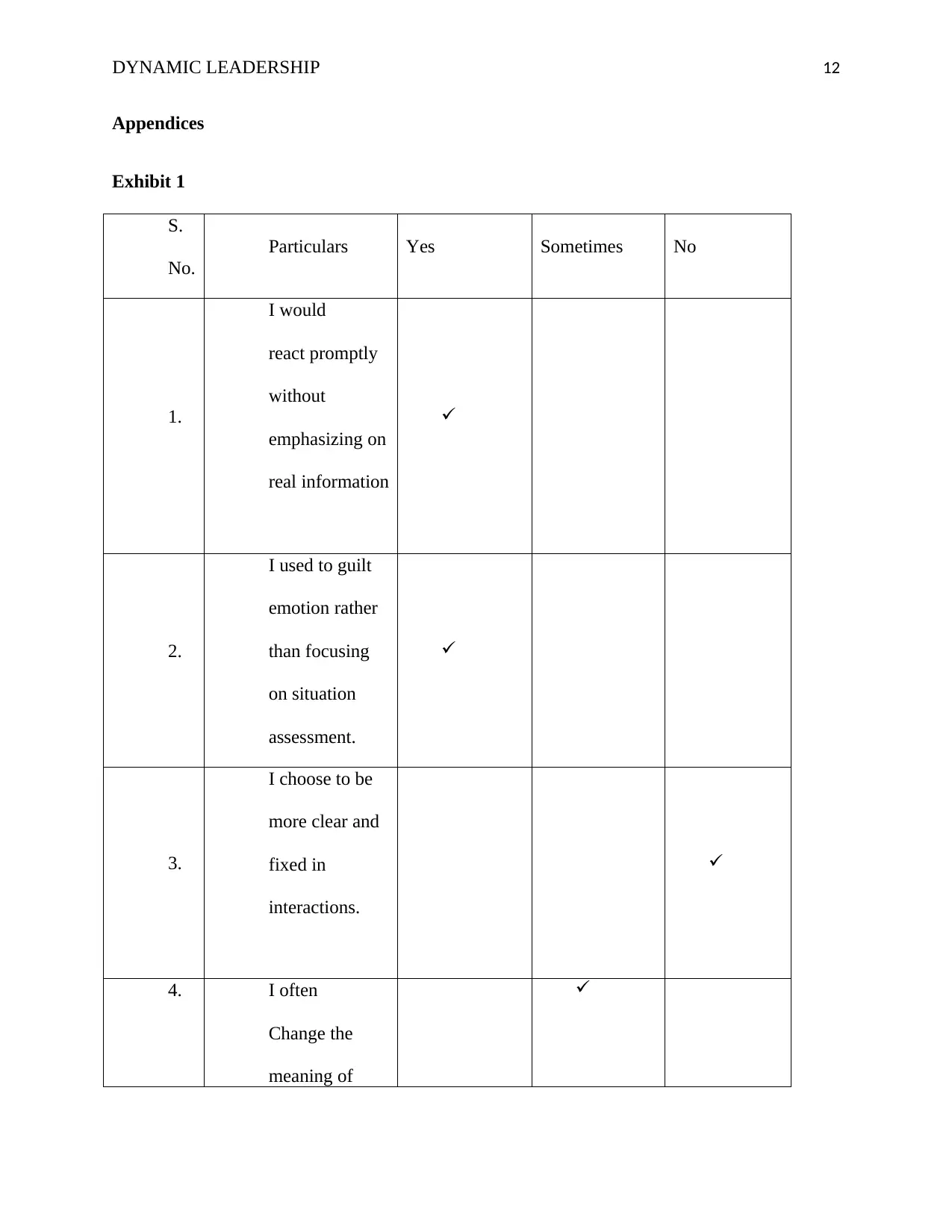
DYNAMIC LEADERSHIP 12
Appendices
Exhibit 1
S.
No.
Particulars Yes Sometimes No
1.
I would
react promptly
without
emphasizing on
real information
2.
I used to guilt
emotion rather
than focusing
on situation
assessment.
3.
I choose to be
more clear and
fixed in
interactions.
4. I often
Change the
meaning of
Appendices
Exhibit 1
S.
No.
Particulars Yes Sometimes No
1.
I would
react promptly
without
emphasizing on
real information
2.
I used to guilt
emotion rather
than focusing
on situation
assessment.
3.
I choose to be
more clear and
fixed in
interactions.
4. I often
Change the
meaning of
⊘ This is a preview!⊘
Do you want full access?
Subscribe today to unlock all pages.

Trusted by 1+ million students worldwide
1 out of 16
Related Documents
Your All-in-One AI-Powered Toolkit for Academic Success.
+13062052269
info@desklib.com
Available 24*7 on WhatsApp / Email
![[object Object]](/_next/static/media/star-bottom.7253800d.svg)
Unlock your academic potential
Copyright © 2020–2025 A2Z Services. All Rights Reserved. Developed and managed by ZUCOL.





